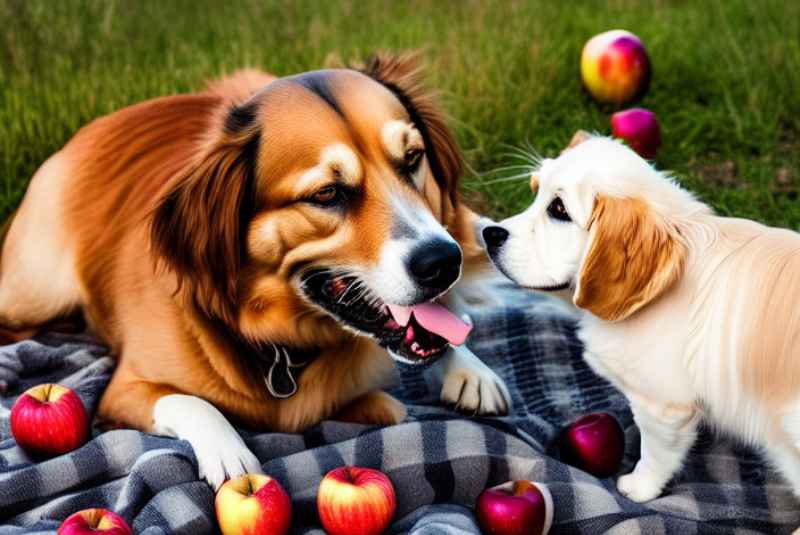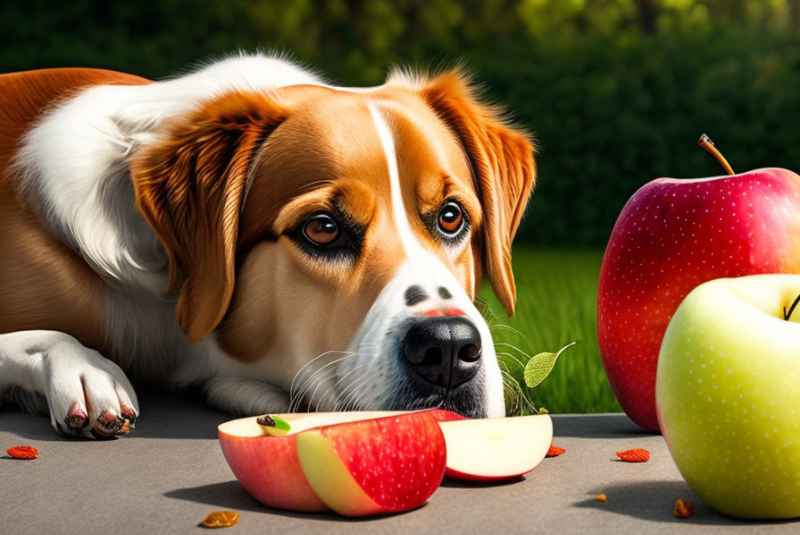The “Best Ways to Feed Apples to Your Dog?” responsible dog owner wants to make sure their pet has a diet that is well-balanced. While feeding them the proper dog food is crucial, you can also consider including some wholesome human foods in their diet. Apples are a great treat for your dog because they are full of fiber and important minerals. In this post, we’ll examine the most wholesome and secure ways to feed apples to your dog.
Preparing Apples for Your Dog
Take a few proactive measures before Best Ways to Feed Apples to Your Dog?. To start, pick organic apples to be clear of any possible pesticide residues. To get dirt and dangerous bacteria off the apple’s skin, give it a good wash. Additionally, you want to remove the core, seeds, and stem because they can be choking hazards and tiny amounts of cyanide.
Read Also: Can Dogs Eat Hamburger Buns?
Benefits of Best Ways to Feed Apples to Your Dog?

Apples offer several benefits when included in your dog’s diet:
- Nutritional Value: Apples are a great source of dietary fiber, which supports a healthy digestive tract, as well as important vitamins and minerals like vitamins A and C.
- Hydration: Apples have a high water content, which helps keep your dog hydrated, especially during hot weather.
- Oral Health: The crunchy texture of apples can help remove plaque buildup on your dog’s teeth, promoting better oral health and fresher breath.
- Antioxidants: Antioxidants included in apples assist prevent cell deterioration and promote general health and well-being.
- Weight Management: Apples are low in calories and can be a healthy substitute for treats that are rich in calories, helping overweight dogs regulate their weight.
Risks Best Ways to Feed Apples to Your Dog?
While apples can be a healthy addition to your dog’s diet, it’s important to be aware of the following risks and considerations:
- Cyanide in Seeds: A little quantity of cyanide, which can be dangerous in large doses, can be found in apple seeds. Before giving your dog an apple, always remove the core and seeds.
- Choking Hazard: Apples should be sliced into small, bite-sized pieces to prevent choking, especially for small dogs or those prone to gulping their food.
- Digestive Upset: To prevent intestinal problems, gradually add apples to your dog’s diet. Apples can have too much fiber, which might result in diarrhea or stomach distress.
- Allergies or Sensitivities: Some dogs may have allergies or sensitivities to apples. Watch for any signs of an allergic reaction, such as itching, vomiting, or diarrhea. If you suspect an allergy, consult your veterinarian.
Read Also: Is Pure Harmony a Good Dog Food?
Feeding Apples to Your Dog

You can introduce the apples to your dog in a number of ways now that you’ve prepped them. To make an apple into bite-sized pieces and serve them as a nutritious snack, use one straightforward technique. To improve the flavor and nutritional content of your dog’s usual diet, you can also puree or mash the apple.
How Much Apple Can Dogs Eat?
Even though apples are often safe for dogs, it’s crucial to practice moderation. The high fiber content of apples might cause diarrhea or upset stomach when consumed in excess. Small dogs can often receive approximately half an apple each day, but larger varieties can take pleasure in an entire slice.
Safety Precautions
Even while apples are typically safe for dogs, there are a few things to watch out for. Best Ways to Feed Apples to Best Ways to Feed Apples to Your Dog? because they contain cyanide, which in excessive doses can be hazardous. To avoid choking problems, pay attention to the size of the apple slices as well. To make sure your dog is eating their apple treat securely, always keep an eye on them as they enjoy it.
Alternatives to Fresh Apples
Here are some alternatives to fresh apples that you can consider for your dog:

Applesauce
If your dog has trouble chewing or prefers softer textures, unsweetened applesauce can be a good substitute. Make sure it is free of artificial sweeteners and added sugars, which can be detrimental to dogs.
Apple Treats
Look for dog treats that are either apple-flavored or made with real apples on the marketplace. These snacks are made especially for dogs and offer the health advantages of apples in a delightful and practical manner.
Dried Apple Rings
Dehydrated apple rings can make a delicious and chewy treat for your dog. Make sure to choose unsweetened and dried apples, as additives can be harmful to dogs.
Frozen Apple Slices
Slice apples into thin pieces and freeze them for a refreshing and crunchy treat. Frozen apple slices can be a great option during hot weather or as a soothing treat for teething puppies.
Apple-Based Dog Food
Apples are an element in some dog food recipes available from certain companies. These foods use apples’ nutritional advantages while offering a balanced and comprehensive meal.
Read Also On Quora: Can dogs eat apples or apple skins?
Conclusion
In the above, we explain the Best Ways to Feed Apples to Your Dog? Apples can be a delicious and healthful addition to your dog’s diet. Remember to wash, remove the core, and seed the apples before cutting them into manageable, safe portions. Always use moderation and keep in mind your dog’s particular requirements and preferences. You can give apples to your dog and benefit from their delicious flavor and health advantages according to these rules.
Can all dogs eat apples?
Yes, most dogs can safely enjoy apples. However, it’s always best to consult with your veterinarian, especially if your dog has any underlying health conditions.
Are there any other fruits I can feed my dog?
Yes, several fruits are safe for dogs, including bananas, blueberries, and strawberries. Remember to introduce new fruits gradually and in moderation.
Can I feed my dog apple peels?
It’s best to remove the apple peels before feeding them to your dog, as they can be difficult to digest and may cause stomach upset.
Are there any signs of apple toxicity in dogs?
If your dog consumes a large amount of apple seeds or shows symptoms such as difficulty breathing, dilated pupils, or seizures, contact your veterinarian immediately.
Can I feed my dog cooked apples?
While cooked apples can be given to dogs in small quantities, avoid adding any additional sweeteners or spices, as they may be harmful to your pet.

1 thought on “Best Ways to Feed Apples to Your Dog?, Benefits and Risks”